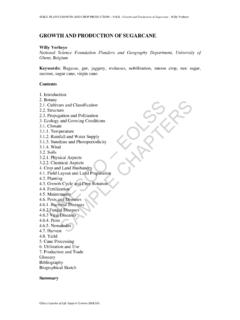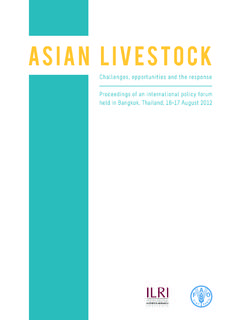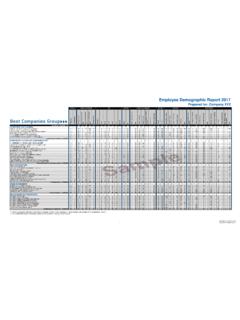Transcription of Desertification and Deforestation in Africa
1 LAND USE, LAND COVER AND SOIL SCIENCES Vol. V Desertification and Deforestation in Africa - R. Penny Desertification AND Deforestation IN Africa . R. Penny Environmental and Developmental Consultant/Practitioner, Cape Town, South Africa Keywords: arid, semi-arid, dry sub-humid, drought, drylands, land degradation, land tenure, sustainability Contents 1. Introduction 2. Global Context 3. Land Degradation in Africa Today Geographical Regions Socio-Economic Aspects S. TE S. 4. Causes and Consequences R. AP LS. Drought and Other Disasters Water Quality and Availability Loss of Vegetative Cover C EO. Loss of Soil Fertility Poverty and Population Effect of Land Tenure Health 5. Combating Desertification E . H. Past Trends Current Attempts to Combat Desertification PL O. Synergy of the Three Sustainable Development Conventions M SC. The Role of Science and Technology in Combating Desertification Synergy in Environmental Policy Development 6.
2 Future Perspectives: The Way Forward 7. Conclusions SA NE. Glossary Bibliography Biographical Sketch U. Summary Africa is particularly vulnerable to Desertification . Two thirds of the continent consists of desert or drylands. The obvious causes of Desertification and Deforestation consist of major ecosystem changes, such as land conversion for various purposes, over- dependence on natural resources and several forms of unsustainable land use. However, the issue of Desertification is inseparable from social problems such as poverty and land tenure issues. Politics, war and national disasters affect the movements of people and thus impact on the land. International trade policies as well play a part in land management and/or exploitation. Combating Desertification and promoting sustainable development in Africa is often one and the same thing, due to the social and economic importance of natural resources and Encyclopedia of life Support Systems (EOLSS).
3 LAND USE, LAND COVER AND SOIL SCIENCES Vol. V Desertification and Deforestation in Africa - R. Penny agriculture. The international community has created systems to address Desertification and its related problems. Countries planning the way forward need to prioritize measures to combat Desertification to maximize their sustainable development efforts. 1. Introduction Desertification is both a human and a physical problem. Over the last 30 years it has become of particular concern to governments, scientists and rural populations. Africa is particularly vulnerable to Desertification since two thirds of the continent is either desert or drylands, and 73% of Africa 's agricultural drylands are already degraded. More than two thirds of the population is made up of subsistence farmers and, therefore, the impact of land degradation is immediate and devastating. Combating Desertification will not only profit those countries affected but also impact on the global environment and economy.
4 Desertification has a direct impact on the S. TE S. biological diversity of our planet as well as on climate change. R. AP LS. It is important to differentiate between the natural expansion and contraction of hyper- arid desert regions and actual Desertification , which is the degradation of existing dry C EO. but productive land, to the point where it can no longer produce food or sustain life . Deserts are often misrepresented as being man-made, whereas they are in fact rich natural ecosystems that function effectively despite scarcity of water or lack of rainfall. The United Nations Convention to Combat Desertification (1995) defines Desertification as: .. land degradation in arid, semi-arid and dry sub-humid areas E . resulting from climatic changes and human activities.. H. PL O. Land degradation is defined as the reduction or loss of the biological and/or ecological productivity of land.
5 The process begins with the loss of vegetative cover and ends with M SC. the destruction of the soil's fertility. It is one of the key symptoms of the unsustainable way in which we manage the planet. The sustainability of a particular piece of land depends on both the properties of the land and the way in which it is managed. It SA NE. involves the weakening of the resilience of the land - in other words the land's ability to recover after a disturbance. The disturbance might be climatic, such as a drought, or human-induced vegetation clearance or crop growing. The greater the disturbance the U. area can recover from, the greater its resilience. Land degradation is often measured in terms of the financial cost of rehabilitating the land. The terms Desertification and land degradation are often used interchangeably and in this chapter they will be examined together with Deforestation .
6 Deforestation is defined as the process whereby trees and vegetation are removed for various purposes, leaving the land partially or completely exposed to the elements. The role that trees and forests play in the ecological well-being of the Earth is well known. Apart from providing a habitat for wildlife, they contribute to stable water supplies, conserve the soil, clean the air and help to regulate the climate. Deforestation is part of the process that leads to land degradation, and the main causes are a number of complex socio-economic factors. These can be broadly categorized as: Encyclopedia of life Support Systems (EOLSS). LAND USE, LAND COVER AND SOIL SCIENCES Vol. V Desertification and Deforestation in Africa - R. Penny Population growth and increasing per capita demands for forest products and therefore forest exploitation, and the conversion of forested land for the purpose of agriculture and other forms of development such as mining.
7 Market failures that undervalue both the benefits of forest ecosystems and the true cost of damage associated with exploitation and conservation. Misdirected policies that result in unintended Deforestation and the inability to preclude preventable Deforestation because of the failure of government institutions to function effectively. Institutional failure that leads to insecure resource rights for forest-dependent communities, and a lack of transparency in forest resource pricing and allocation processes which, in turn, encourage corruption and the misuse of forest resources. The conversion of forests into unsustainable cultivation or unsustainable grazing produces only short-term productivity gains at the expense of long-term benefits S. TE S. through sustainable utilization. There are both environmental and social costs associated R. AP LS. with Deforestation . 2. Global Context C EO.
8 The United Nations Environment Program (UNEP) estimates that Desertification affects 70% of all drylands, or 25% of the Earth's surface ( billion hectares). Desertification is widespread and represents a global problem. It is estimated that over 900 million people in 100 countries, some in the least developed countries in the world, are directly E . affected by it and the livelihoods of a further one billion people are at risk - one sixth of H. the earth's human population (Figure 1). PL O. M SC. SA NE. U. Figure 1: Global land area by aridity zone (%) (Source: UNEP World Atlas of Desertification ). Encyclopedia of life Support Systems (EOLSS). LAND USE, LAND COVER AND SOIL SCIENCES Vol. V Desertification and Deforestation in Africa - R. Penny The situation in Africa is particularly acute, but even the densely populated Asian and Pacific regions contain roughly million hectares of degraded drylands, while parts of Italy, Spain and other European countries are also affected.
9 Surprisingly, the continent which has the highest proportion of its drylands severely or moderately degraded is North America, with 74% compared to Africa 's 73%. 3. Land Degradation in Africa Today Two thirds of Africa consists of desert or drylands of which almost three quarters are moderately to severely degraded. Rainfall is unreliable and the areas are afflicted by frequent and severe droughts, yet most rural people rely heavily on agriculture and natural resources for their subsistence. Since 73% of the agricultural drylands are already degraded to some degree it is not surprising that the highest incidence of poverty occurs in the drylands (Figure 2). S. TE S. R. AP LS. C EO. E . H. PL O. M SC. SA NE. U. Figure 2: Soil and vegetation degradation severity in Africa . Based on information from UNEP World Atlas of Desertification (2nd ed.) London, The direct relationship between the environment and the economy, as well as the dependency of Africa 's development upon the natural resource base, increases the need for urgent action to be taken to arrest ecological decline.
10 Since the second half of the Encyclopedia of life Support Systems (EOLSS). LAND USE, LAND COVER AND SOIL SCIENCES Vol. V Desertification and Deforestation in Africa - R. Penny twentieth century, all Sahelian countries have been facing a dramatic increase in population, consecutive years of little or no rain, a severe decline in the availability of natural resources due to land degradation, structural economic problems and frequent exceptional food emergencies as a result of crop loss and civil strife. Not only is there a trend towards less rainfall, but rainfall has also become less predictable. The Sahelian drought and famine of 1968-1974 drew the attention of the international community. At first, only large-scale relief was given to the drought-stricken countries. Concrete measures to combat Desertification and rehabilitation programs could not be initiated at this early stage as no long-term ecological and socio-economic field surveys had been undertaken to examine the complex causes and impacts of Desertification .

















